
Am Fam Physician. 2014;90(7):476-480
Author disclosure: No relevant financial affiliations.
More than 25 million Americans speak English “less than very well,” according to the U.S. Census Bureau. This population is less able to access health care and is at higher risk of adverse outcomes such as drug complications and decreased patient satisfaction. Title VI of the Civil Rights Act mandates that interpreter services be provided for patients with limited English proficiency who need this service, despite the lack of reimbursement in most states. Professional interpreters are superior to the usual practice of using ad hoc interpreters (i.e., family, friends, or untrained staff). Untrained interpreters are more likely to make errors, violate confidentiality, and increase the risk of poor outcomes. Children should never be used as interpreters except in emergencies. When using an interpreter, the clinician should address the patient directly and seat the interpreter next to or slightly behind the patient. Statements should be short, and the discussion should be limited to three major points. In addition to acting as a conduit for the discussion, the interpreter may serve as a cultural liaison between the physician and patient. When a bilingual clinician or a professional interpreter is not available, phone interpretation services or trained bilingual staff members are reasonable alternatives. The use of professional interpreters (in person or via telephone) increases patient satisfaction, improves adherence and outcomes, and reduces adverse events, thus limiting malpractice risk.
More than 25 million Americans speak English “less than very well,” according to the U.S. Census Bureau, and more than 60 million speak a language other than English at home.1 This population is the least likely to receive preventive care, have access to regular care, or be satisfied with their care.2 Patients with limited English proficiency are much more likely to have adverse effects from drug complications, poor understanding of diagnoses, low health literacy, and a greater risk of being misunderstood by their physicians.3,4
| Clinical recommendation | Evidence rating | References |
|---|---|---|
| Use of a trained interpreter meets the legal requirements of Title VI of the Civil Rights Act and should be offered to patients with limited English proficiency. | C | 5, 15, 24 |
| When using an interpreter, the clinician should address the patient directly in the first person. | C | 10 |
| Seating the interpreter next to or slightly behind the patient facilitates better communication. | C | 10, 13 |
| When using an interpreter, the clinician should allow for sentence-by-sentence interpretation. | C | 6 |
| A trained interpreter should be used to improve communication (resulting in fewer errors), clinical outcomes, and satisfaction with care in patients with limited English proficiency. | B | 4, 8, 17, 23 |
Title VI of the Civil Rights Act requires interpreter services for all patients with limited English proficiency who are receiving federal financial assistance, with the exception of Medicare Part B.5 Failure to provide these services when necessary is considered discriminatory and illegal. In most states, however, these services are an unfunded mandate because Medicaid, Medicare, and most private insurers do not pay for interpreter services,5 although a prolonged service fee may be appropriate because of the extra time required for office visits.6 The American Academy of Family Physicians supports legislation to improve health care access and provide funding for patients with limited English proficiency and those who are deaf,7 but because professional interpreter services are not reimbursable, many clinicians still rely on family, friends, or bilingual staff as ad hoc interpreters, which increases the risk of patient dissatisfaction, medical errors, unnecessary testing, poor adherence, and malpractice exposure.5,8 In one example, office staff misinterpreted the word intoxicado as intoxicated instead of the intended meaning of inadvertent toxicity. A fruitless evaluation for drug abuse was conducted while an intracerebral hemorrhage was missed, resulting in a $71 million malpractice award.9
Professional medical interpreters are trained to interpret the spoken word, whereas translators work with written words. Although the two professions are often confused, they require different skill sets, with interpreters working in live situations.10 National certification for medical interpreters is still fairly new and is provided by the Certification Commission for Healthcare Interpreters (http://www.cchicertification.org) or the National Board of Certification for Medical Interpreters (http://www.certifiedmedicalinterpreters.org). The Registry of Interpreters for the Deaf provides certification for deaf interpretation (http://www.rid.org).
Choosing an Interpreter
Professional interpreters are often not available, although larger institutions and universities employ them or use employee or community language banks as needed. Therefore, multilingual staff members should be encouraged to receive additional training in interpretation technique; fluency alone does not make them effective interpreters. With more than 100 languages spoken in the United States,4 the most feasible option for most offices is usually a telephone service such as LanguageLine Solutions (http://languageline.com) or CyraCom Language Solutions (http://www.cyracom.com). Soon after a request, an on-call trained interpreter is connected by phone for the interview. Clinics can subscribe to the service or pay per call ($2 to $3 per minute without a contract). Use of telephone interpreters is not inferior to having a bilingual health care professional.11 However, if a patient insists on having a family member as an interpreter, this should be recorded in the patient's chart.6
Interpreter services for patients who are deaf are usually provided through video remote interpreting, in which a two-way video link facilitates American sign language communication. Video relays (on-screen sign language interpreters), closed captioning (spoken words appearing on screen), telephone typewriters, lip reading, and simple texting or writing are alternative means of communication. It is not advisable to rely on computerized translation services in which typed phrases are automatically translated online or spoken with a prerecorded voice. These are often rough renderings that miss critical information, even when used for something as simple as prescription labels.12 However, they may have a role in translating specific medical terms that are misunderstood by patients who are otherwise fluent in English.
Using an Interpreter
Table 1 lists tips for using medical interpreters. It is best to meet briefly with the interpreter before the patient encounter to make sure he or she is the appropriate choice, give some clinical background, build rapport, and set goals.13 This is especially important with untrained interpreters; coaching on technique can greatly facilitate the interview. The interviewer should speak in the first person (“I” statements), not the third person (e.g., “tell her,” “he said”), and speak directly to the patient, whereas the interpreter should function as an inconspicuous conduit for the conversation.10 This is facilitated by seating the interpreter next to or slightly behind the patient.10,13 The clinician should speak in short sentences, then wait for the interpreter to convey them.6 Jargon, idioms, acronyms, and jokes should be avoided; attempts at humor are often lost in interpretation. Participants must aim for complete transparency, where everything said is interpreted for everyone present.14 Because most patients comprehend at least some English, it is advisable to refrain from making comments that the patient should not hear.10 Control of the interview is maintained by limiting tangential discussions.
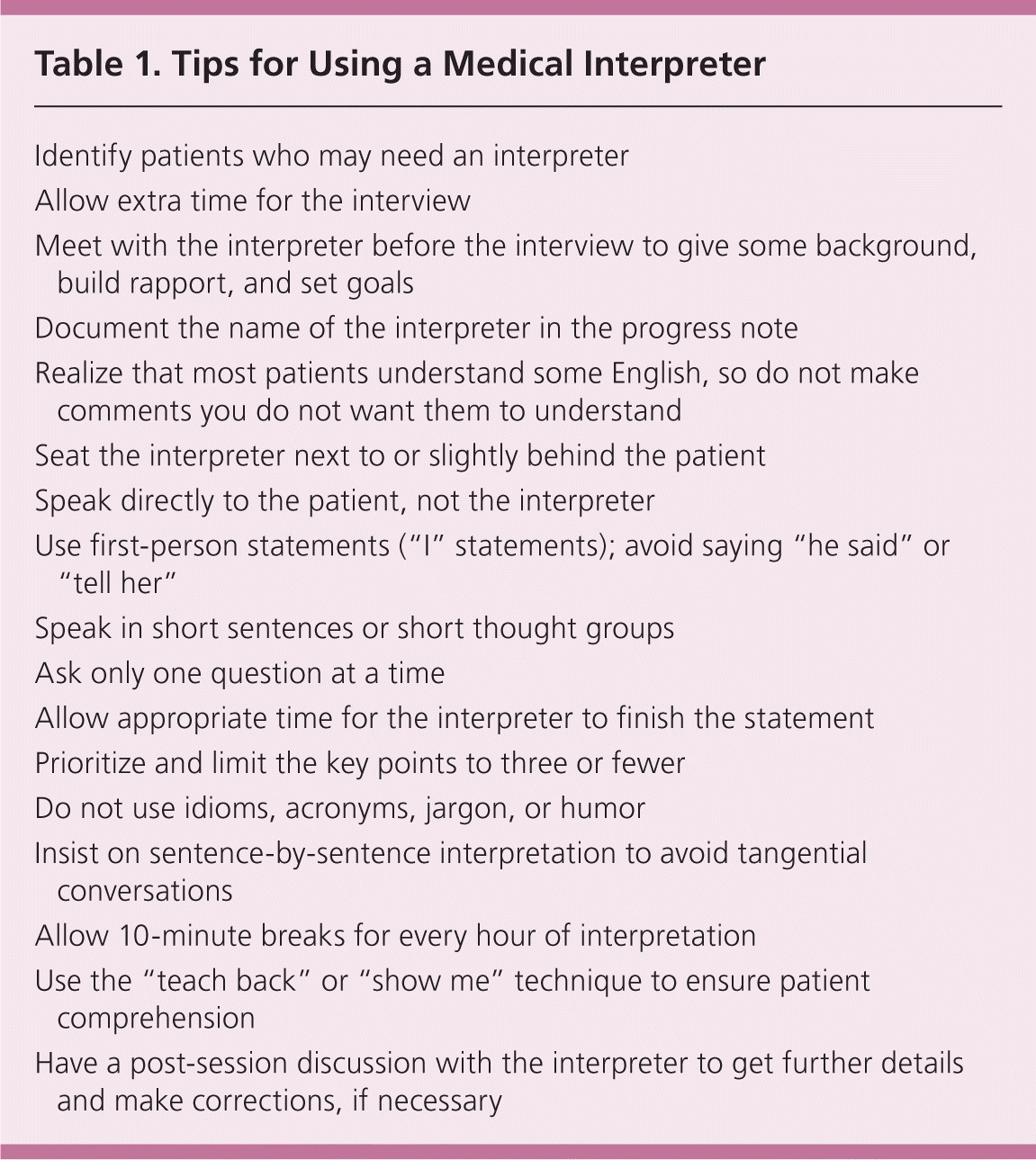
| Identify patients who may need an interpreter |
| Allow extra time for the interview |
| Meet with the interpreter before the interview to give some background, build rapport, and set goals |
| Document the name of the interpreter in the progress note |
| Realize that most patients understand some English, so do not make comments you do not want them to understand |
| Seat the interpreter next to or slightly behind the patient |
| Speak directly to the patient, not the interpreter |
| Use first-person statements (“I” statements); avoid saying “he said” or “tell her” |
| Speak in short sentences or short thought groups |
| Ask only one question at a time |
| Allow appropriate time for the interpreter to finish the statement |
| Prioritize and limit the key points to three or fewer |
| Do not use idioms, acronyms, jargon, or humor |
| Insist on sentence-by-sentence interpretation to avoid tangential conversations |
| Allow 10-minute breaks for every hour of interpretation |
| Use the “teach back” or “show me” technique to ensure patient comprehension |
| Have a post-session discussion with the interpreter to get further details and make corrections, if necessary |
Although interpreters function primarily as conduits for a discussion, they may secondarily serve as clarifiers, cultural liaisons, or patient advocates.15 Clarification occurs when the interpreter interjects a brief explanation, often prefaced by the words “the interpreter would like to state….” The interpreter can also function as a cultural liaison to help the clinician understand cultural beliefs about illness causation or care. The interpreter may even serve as a patient advocate by helping the physician understand barriers to dietary modifications, filling prescriptions, or proper follow-up.15
Common Pitfalls
The use of untrained interpreters is the proverbial “broad path of least resistance,” resulting in many pitfalls. Ad hoc interpreters—usually friends or family—have multiple limitations (Table 2).4,8,13,16–19 The clinician does not know how effectively his or her message is being interpreted, which makes it easy to lose control of the interview. Nonprofessional interpreters have not received training about the Health Insurance Portability and Accountability Act and may not be aware of the need for confidentiality. Other potential problems include unfamiliarity with medical terminology, embarrassment about intimate or sexual issues (about which the interpreter may substitute euphemisms), unsolicited advice, and mixed motives or personal agendas.17 The use of younger children as interpreters is especially problematic because of their limited understanding of adult issues,16 and this practice is forbidden in several states. The use of nonprofessional interpreters increases the risk of nonequivalent interpretations, leading to possible misunderstandings.19 Partially bilingual physicians face yet another pitfall: deciding to use their own limited language skills vs. hiring an interpreter. It is much easier to ask questions in another language than to understand the response. Overconfidence in one's language abilities can lead to serious errors and substandard care.20
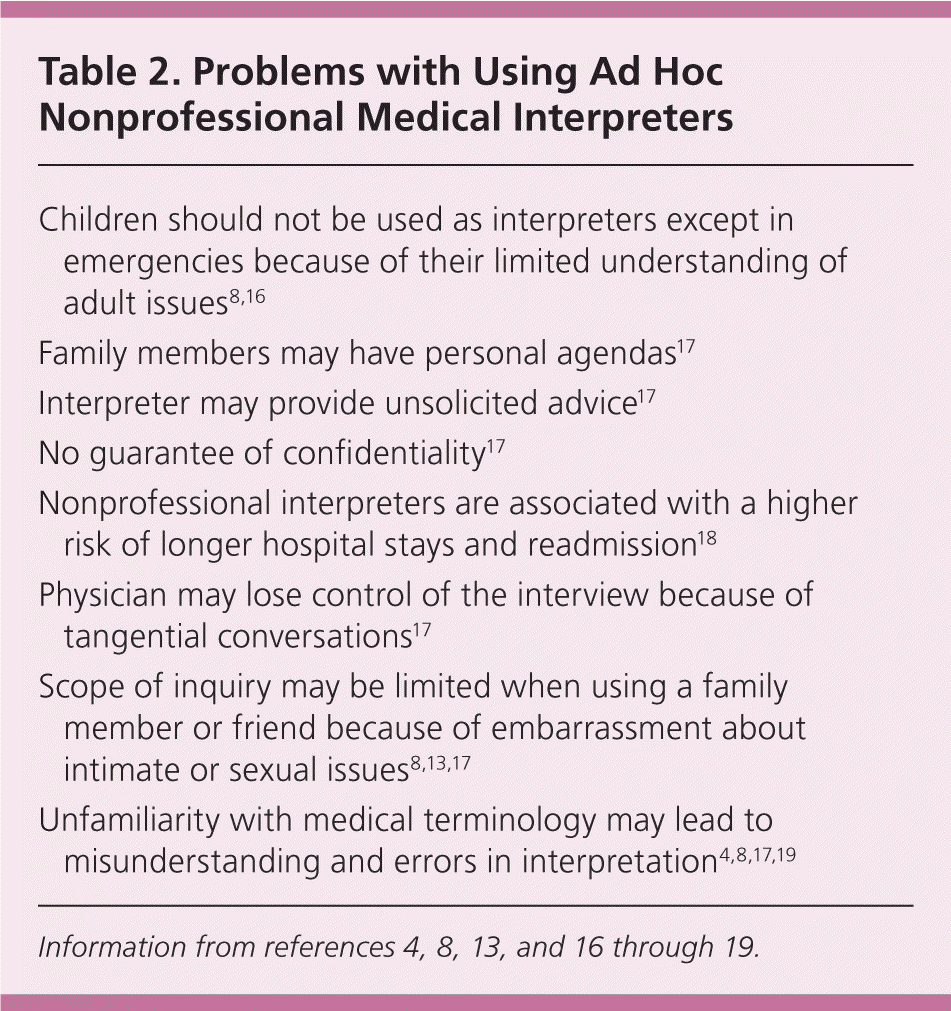
| Children should not be used as interpreters except in emergencies because of their limited understanding of adult issues8,16 |
| Family members may have personal agendas17 |
| Interpreter may provide unsolicited advice17 |
| No guarantee of confidentiality17 |
| Nonprofessional interpreters are associated with a higher risk of longer hospital stays and readmission18 |
| Physician may lose control of the interview because of tangential conversations17 |
| Scope of inquiry may be limited when using a family member or friend because of embarrassment about intimate or sexual issues8,13,17 |
| Unfamiliarity with medical terminology may lead to misunderstanding and errors in interpretation4,8,17,19 |
Even when using a professional interpreter, care must be taken to avoid common mistakes (Table 3). More than one-third of all Americans have limited health literacy, which leads to difficulties in navigating the complex U.S. health care system21; this is especially true for patients with limited English proficiency. Limiting the discussion to three major points may help avoid overwhelming the patient and interpreter.22 Patients often do not understand directions, even though they may nod or say they do. It is best to use the “teach back” or “show me” technique, in which the patient is asked to repeat the directions in his or her own words.22 If the patient is unable to do so, the directions should by explained again through the interpreter, and the patient should continue trying until he or she expresses full understanding.
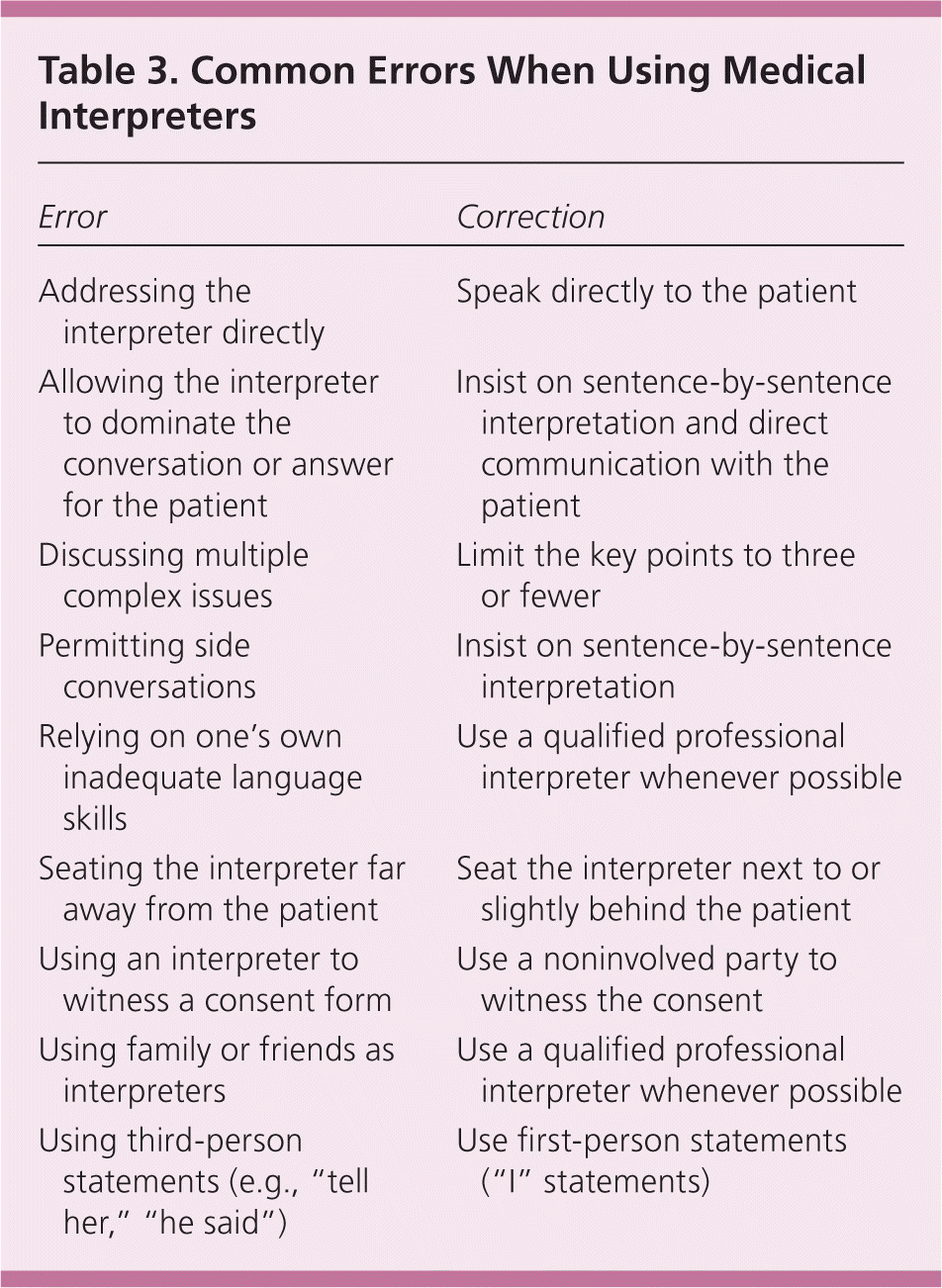
| Error | Correction |
|---|---|
| Addressing the interpreter directly | Speak directly to the patient |
| Allowing the interpreter to dominate the conversation or answer for the patient | Insist on sentence-by-sentence interpretation and direct communication with the patient |
| Discussing multiple complex issues | Limit the key points to three or fewer |
| Permitting side conversations | Insist on sentence-by-sentence interpretation |
| Relying on one's own inadequate language skills | Use a qualified professional interpreter whenever possible |
| Seating the interpreter far away from the patient | Seat the interpreter next to or slightly behind the patient |
| Using an interpreter to witness a consent form | Use a noninvolved party to witness the consent |
| Using family or friends as interpreters | Use a qualified professional interpreter whenever possible |
| Using third-person statements (e.g., “tell her,” “he said”) | Use first-person statements (“I” statements) |
Benefits and Requirements
The benefits of using professional interpreters are well documented (Table 4).4,5,8,15,17–19,23,24 In addition to clear interpretation with fewer errors, interviews with trained interpreters are associated with improved comprehension and significantly greater patient satisfaction,23 better care and compliance, and lower risk of adverse events, thus mitigating malpractice risk.17 The use of professional interpreters also reduces hospital stays and readmission rates.18
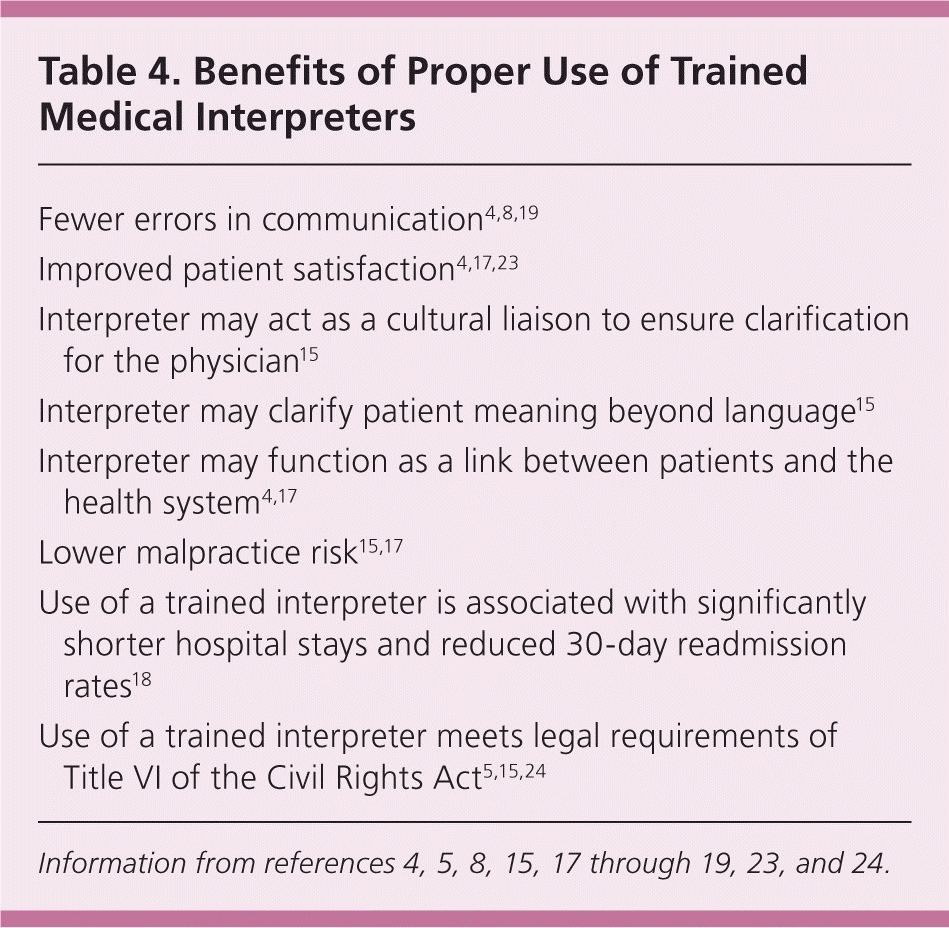
| Fewer errors in communication4,8,19 |
| Improved patient satisfaction4,17,23 |
| Interpreter may act as a cultural liaison to ensure clarification for the physician15 |
| Interpreter may clarify patient meaning beyond language15 |
| Interpreter may function as a link between patients and the health system4,17 |
| Lower malpractice risk15,17 |
| Use of a trained interpreter is associated with significantly shorter hospital stays and reduced 30-day readmission rates18 |
| Use of a trained interpreter meets legal requirements of Title VI of the Civil Rights Act5,15,24 |
The National Standards for Culturally and Linguistically Appropriate Services include four mandates: (1) language assistance for patients with limited English proficiency should be offered at no cost; (2) patients should be notified of the availability of language assistance services in their preferred language, both verbally and in writing; (3) the competence of interpreters should be ensured, and the use of untrained persons or minors as interpreters should be avoided; and (4) easily understood print materials and signage should be provided in the languages commonly used in the service area.24 Additionally, the Joint Commission, which accredits and certifies health care organizations in the United States, requires that hospital staff effectively communicate with patients when providing care, treatment, and services, and recommends language interpreters as one of the best options.20 Table 5 lists several online resources available to physicians.
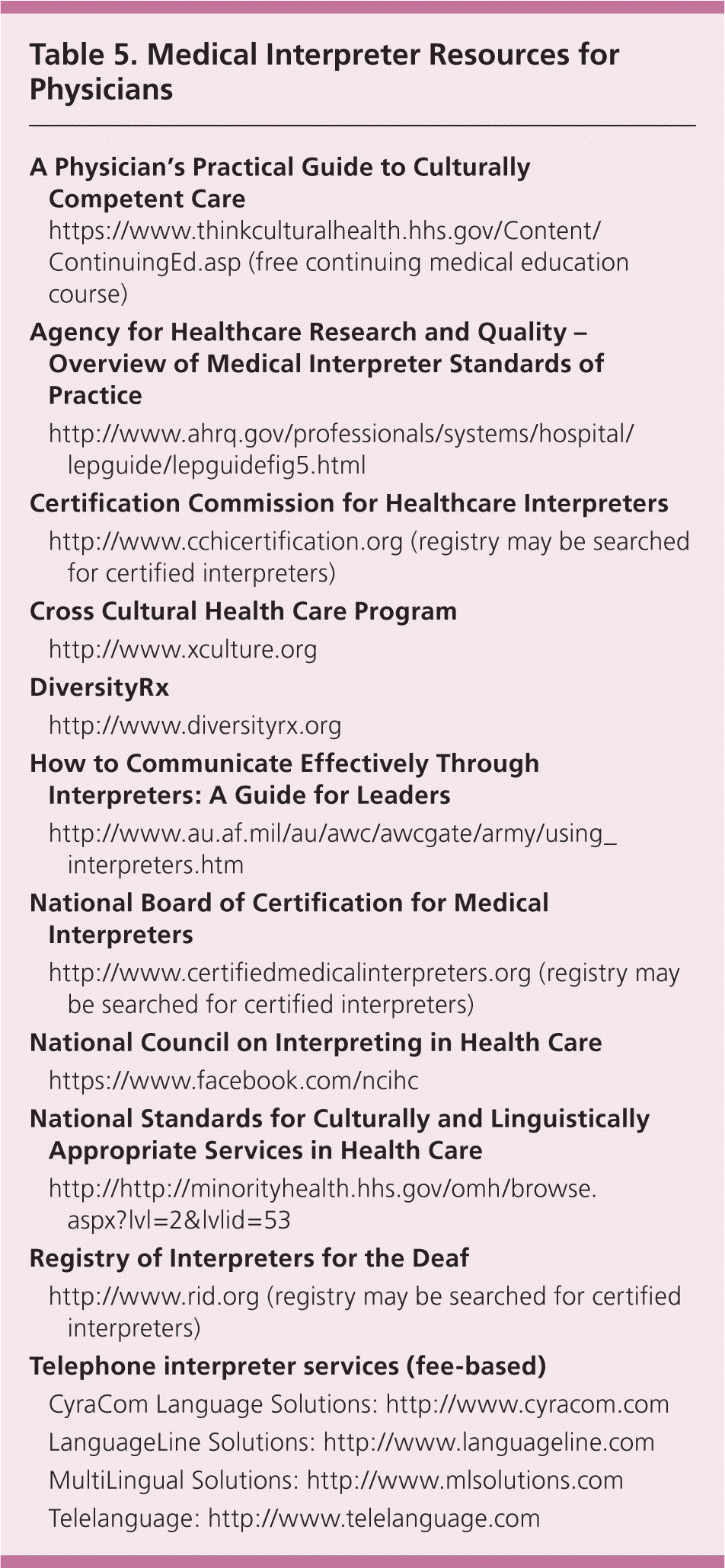
| A Physician's Practical Guide to Culturally Competent Care | |
| https://www.thinkculturalhealth.hhs.gov/Content/ContinuingEd.asp (free continuing medical education course) | |
| Agency for Healthcare Research and Quality – Overview of Medical Interpreter Standards of Practice | |
| http://www.ahrq.gov/professionals/systems/hospital/lepguide/lepguidefig5.html | |
| Certification Commission for Healthcare Interpreters | |
| http://www.cchicertification.org (registry may be searched for certified interpreters) | |
| Cross Cultural Health Care Program | |
| http://www.xculture.org | |
| DiversityRx | |
| http://www.diversityrx.org | |
| How to Communicate Effectively Through Interpreters: A Guide for Leaders | |
| http://www.au.af.mil/au/awc/awcgate/army/using_interpreters.htm | |
| National Board of Certification for Medical Interpreters | |
| http://www.certifiedmedicalinterpreters.org (registry may be searched for certified interpreters) | |
| National Council on Interpreting in Health Care | |
| https://www.facebook.com/ncihc | |
| National Standards for Culturally and Linguistically Appropriate Services in Health Care | |
| http://http://minorityhealth.hhs.gov/omh/browse.aspx?lvl=2&lvlid=53 | |
| Registry of Interpreters for the Deaf | |
| http://www.rid.org (registry may be searched for certified interpreters) | |
| Telephone interpreter services (fee-based) | |
| CyraCom Language Solutions: http://www.cyracom.com | |
| LanguageLine Solutions: http://www.languageline.com | |
| MultiLingual Solutions: http://www.mlsolutions.com | |
| Telelanguage: http://www.telelanguage.com | |
Data Sources: We searched PubMed, Clinical Evidence, the Cochrane Database of Systematic Reviews, and Medline (Ovid) using the terms medical interpretation, interpretation for the deaf, interpretation techniques, ethics for interpreters, limited English proficiency, language barriers in medicine, telephone interpretation, certification of health care interpreters, health literacy, teach back, and National Standards for Culturally and Linguistically Appropriate Services (CLAS). Search dates: May 2013 to August 2014.
